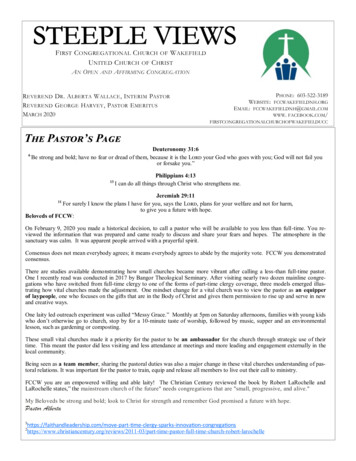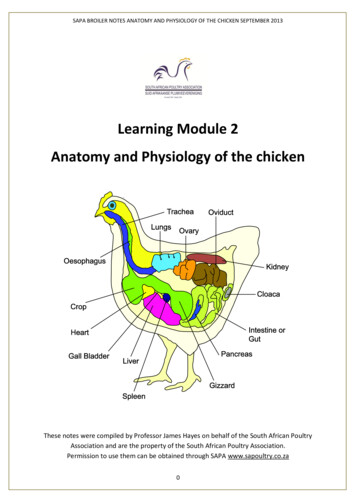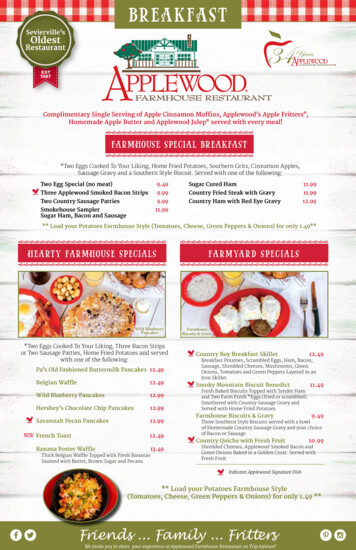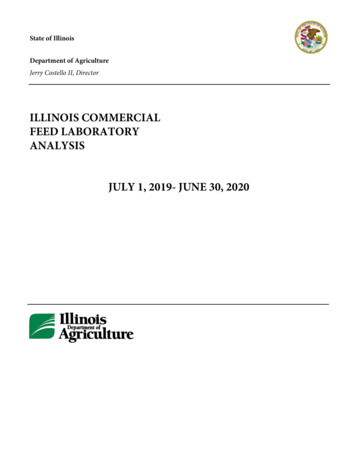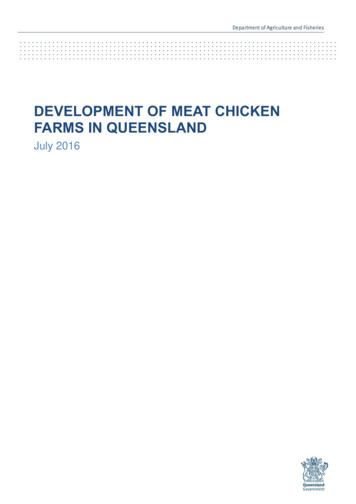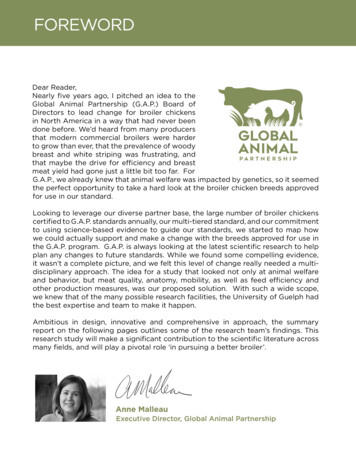
Transcription
Dear Reader,Nearly five years ago, I pitched an idea to theGlobal Animal Partnership (G.A.P.) Board ofDirectors to lead change for broiler chickensin North America in a way that had never beendone before. We’d heard from many producersthat modern commercial broilers were harderto grow than ever, that the prevalence of woodybreast and white striping was frustrating, andthat maybe the drive for efficiency and breastmeat yield had gone just a little bit too far. ForG.A.P., we already knew that animal welfare was impacted by genetics, so it seemedthe perfect opportunity to take a hard look at the broiler chicken breeds approvedfor use in our standard.Looking to leverage our diverse partner base, the large number of broiler chickenscertified to G.A.P. standards annually, our multi-tiered standard, and our commitmentto using science-based evidence to guide our standards, we started to map howwe could actually support and make a change with the breeds approved for use inthe G.A.P. program. G.A.P. is always looking at the latest scientific research to helpplan any changes to future standards. While we found some compelling evidence,it wasn’t a complete picture, and we felt this level of change really needed a multidisciplinary approach. The idea for a study that looked not only at animal welfareand behavior, but meat quality, anatomy, mobility, as well as feed efficiency andother production measures, was our proposed solution. With such a wide scope,we knew that of the many possible research facilities, the University of Guelph hadthe best expertise and team to make it happen.Ambitious in design, innovative and comprehensive in approach, the summaryreport on the following pages outlines some of the research team’s findings. Thisresearch study will make a significant contribution to the scientific literature acrossmany fields, and will play a pivotal role ‘in pursuing a better broiler’.
Final Research Results Report Prepared for Global Animal PartnershipPrepared July 23, 2020Principal Investigators: Stephanie Torrey1,2*, Elijah Kiarie1 Tina Widowski1,2Collaborators: Ira Mandell1, Niel Karrow1, Dan Tulpan1, Michelle Edwards3Post-doctoral fellows: Mohsen Mohammadigheisar1, Lauren Dawson1,2, Aitor Arrazola1,2Graduate students: Midian Nascimento dos Santos1,2, Daniel Rothschild1,2, Zhenzhen Liu1,21Department of Animal Biosciences, University of Guelph, Guelph, ON, CanadaCampbell Centre for the Study of Animal Welfare, University of Guelph, Guelph, ON, Canada3Ontario Agricultural College, University of Guelph, Guelph, ON, Canada2*corresponding author: storrey@uoguelph.ca
In Pursuit Of A Better Broiler: A Comprehensive Study On 16 Strains OfBroiler Chickens Differing In Growth RatesTo meet the changing and growing consumer demand for chicken meat, the poultry industry hasselected broiler chickens for increasing efficiency and breast yield. While this high productivity meansaffordable, consistent product, it has come at a cost to broiler welfare. There has been increasingadvocacy and consumer pressure on primary breeders, producers, processors and retailers to improvethe welfare of the billions of chickens processed annually. Several small-scale studies have reportedbetter welfare outcomes for slower growing strains compared to fast growing, conventional strains.However, these studies often housed birds with range access or used strains with vastly different growthrates. Additionally, there may be traits other than growth, such as body conformation, that affectwelfare. As the global poultry industry considers the implications of using slower strains, there was aneed for a comprehensive, multidisciplinary examination of broiler chickens with a wide range ofgenotypes differing in growth rate and other phenotypic traits.Our scientific team at Guelph, including expertise in animal welfare science, poultry nutrition, meatscience, immunology, physiology, phenomics and biostatistics, designed this study to benchmark data onconventional and slower growing strains of broiler chickens reared under identical conditions. Westudied over 7,500 broiler chickens from 16 different genetic strains over a two-year period with theobjective to understand differences in behaviour, mobility, anatomy, physiology, mortality, feedefficiency and carcass and meat quality as they relate to the strains’ growth rates. We categorizedstrains by growth rate (as conventional (CONV), fastest slow strains (FAST), moderate slow strains(MOD) and slowest slow strains (SLOW)) to facilitate decision makers in their policy development,breeding goals or purchasing decisions based on animal welfare, production, efficiency and productquality.Categorization of strains based on average daily gain (ADG)to Target Weight 2 (approximately 3.2 kg). Due to small sample size,strains A and T are included for descriptive purposes only.StrainABCMFIGHESOJDNKTADG, g/dTarget weight 1Target weight DSLOWSLOWSLOWSLOW-
We examined the strains at similar bodyweights (Target Weights) and similarages, to understand if any differencesrelated to weight or age.Within the same experimental room, strains were reared over eight trials and housed in identical pens at30 kg/m2 (placement of 44 birds/pen) with enrichments that facilitated physical and oral activity.Environmental enrichments within theexperimental pens. Birds are on the raised platform,on the ramp to the platform, perching on the waterline, standing on the mineral Peckstone andinteracting with the rope. A hanging scale was alsoavailable.We studied the broilers’ welfare by considering whether they might be experiencing pain or poor health,and whether they can perform motivated behaviour. We examined the potential for pain indirectlythrough the birds’ general behaviour and activity levels, through tests of mobility and through thepresence of painful footpad lesions and hock burns. The fastest growing strains spent more time sitting,and less time standing and walking than slower strains, even at the same ages. For example, at 26 days ofage, CONV strains spent 73.6% of their time sitting, 4.2% of their time standing and 2.3% of their timewalking. At the same age, all other strains spent an average of 63% of their time sitting, 7.8% of theirtime standing, and 4.3% of their time walking. Time spent sitting, standing and walking can be animportant welfare indicator if differences relate to a bird’s inability to stand and walk, or ifdifferences increase the birds’ risk for contact dermatitis (footpad lesions and hock burns).
All birds decreased use of enrichments withage, but the SLOW strains usedthe enrichments more than faster growingstrains at all ages. Use of enrichment mayreflect physical capabilities, spacelimitations or individual temperament.Differences among categories in use ofenrichments over time. The CONV (inblue) and FAST strains (in orange) used theenrichments the least. Different superscriptsindicate differences within an ageWe outfitted a sub-sample of birds with wearable devices to measure their inactivity levels over time.Birds spent a large majority of their time (70-80%) inactive, and inactivity increased with age for allstrains. However, inactivity corresponded with growth rate; faster growing birds were more inactive thanslower growing birds at the same age. Inactivity becomes a welfare concern if the birds are motivatedto be active and cannot due to physical limitations, or if the inactivity itself causes welfare issuessuch as contact dermatitis.A broiler with an Actical activity monitor on its back. Weused flexible cotton straps placed around their wings to make a‘backpack’ for the birds with the 22 g device. This bird was alsocoloured for easy identification within the groupDifferences in inactivity among categoriesof strains over time. CONV strains (inblue) were more inactive than other strains at4 and 5 weeks of age. FAST strains weremore inactive than slower growing strains at4 weeks of age.
Group Obstacle Test. In this test, the feederwas removed one hour prior to the test. Birdswere moved to the back of the pen and a woodenbeam was placed between the feeder and drinkerfor a 5-hour period. Birds had to cross the beamto access feed and water. We measured thenumber of times the sentinel (painted) birdscrossed the beam.To study birds’ mobility, we used two behavioural tests: the latency to lie test and the group obstacle test.These two tests have been validated against traditional gait-scoring systems and permit objectivecomparisons between strains that naturally vary in body size, leg length and conformation. The latency tolie test evaluates birds’ ability to avoid a potentially aversive experience, sitting in water, by remainingstanding during the 10-minute test period. When tested at the first target weight, the latency to liecorresponded with body weight; heavier birds had shorter latencies to lie than lighter birds. At the secondtarget weight, the latency to lie corresponded with growth rate; faster growing strains had shorter latenciesto lie than slower growing strains. This may indicate differences in muscle fatigue related to growththat limits faster growing strains in supporting their body weight.Differences in number of crossings duringgroup obstacle test among categories ofstrains prior to Target Weights 1 and 2.There were fewer obstacle crossings withincreasing growth rates.The obstacle test evaluates broilers’ ability ormotivation to cross a physical barrier to accessfeed and water. Over the five-hour long groupobstacle test, the number of crossingscorresponded with growth rate, with CONVand FAST crossing the obstacle fewer timesthan SLOW strains. This difference mayindicate differences in functional legstrength that may limit the fastest growingstrains from accessing important resources.
Mild and severe footpad lesion scores bycategory and target weight.The CONV and SLOW strains had theworst footpad lesion scores. These lesionsrelate to poor litter condition, influenced bydifferent behaviour patterns. For theconventional strains, their high feed intake(and excreta output) coupled with lowactivity levels caused poor litter conditions.For SLOW strains, their use of enrichments(including perching on the drinker lines)may have caused water leakage andinconsistent litter conditions. The CONVand FAST strains had worse hock burnscores, which relates to the time they spentsitting on wet litter. In general, growth rate reduced activity levels, mobility and interactions withenvironmental enrichments, and was related to increased footpad lesions and hock burns, whichare known to be painful.When looking at the broilers’ health, we found no effect of growth rate on mortality and there were nodisease outbreaks, despite the use of an antibiotic-free diet. Overall mortality was 2.52%. There were alsofew indicators of ascites or bone quality issues, such as tibial dyschondroplasia and long bonedeformities, indicating the successful incorporation of these factors into selection indices across strains.The CONV strains also had the strongest tibiae.Differences in relative tibia breaking strength (TBS, N/kg) among categories of strains at TargetWeights 1 and 2. Different superscripts denote differences within target weight.CONVFASTMODSLOWTarget Weight 1BW (g)TBS (N/kg)1857.8 40.85d155.6 6.84a2519.6 38.45a120.7 3.60c2359.8 34.09b121.0 3.43cc2014.6 28.97134.1 3.77bTarget Weight 2BW (g)TBS (N/kg)3272.1 59.39ab111.5 3.95a3438.6 48.30a94.8 2.58b3190.4 42.13b99.4 2.57bc2846.5 37.44112.6 2.89aThere were also differences in biochemical indicators of metabolic dysfunction and relative organ weightsthat related to growth rates and breast yield. Strains that had the highest growth rates and breast yields hadthe highest concentrations of biochemical markers associated with muscle damage. The fastest growingstrains had disproportionate heart and lung development, which may negatively influence theircardiopulmonary functioning. CONV had 50% higher concentrations of aspartate transaminase (AST), creatine kinase (CK)and lactate dehydrogenase (LDH) than other strains. Strains with the highest breast yield had thehighest concentrations of AST, CK and LDH.CONV had 5-18% heavier relative heart weights (controlled for BW), and 3-14% lighter relativelung weights (controlled for BW) than other strains.
When considering production, efficiency and product quality, strains differed in their body weights,growth rates, feed intake and feed efficiency. The fastest growing stains had the highest feed intake andbest feed efficiency. Slower growing strains had feed conversion ratios that were 13-43 points higher(worse) than CONV.Production and efficiency of categories of broiler chickens at Target Weights 1 and 2. At TW1,CONV was 34 d of age and the other categories were 48 d of age. At TW2, CONV was 48 d of age andthe other categories were 62 d of age. Different superscripts within a row signify significantdifferences. All variables were corrected for mortality.BW (kg)ADG (g)ADFI (g)FCRTW1TW2TW1TW2TW1TW2TW1TW2CONV1.838 0.0674b3.202 0.0674b55.86 1.245a68.92 1.246a87.19 2.084a102.90 2.498a1.49 0.035a1.54 0.061aFAST2.367 0.0567a3.433 0.0567a51.38 1.004b56.03 1.004b83.78 2.201b97.54 2.201ab1.70 0.048bc1.76 0.048bMOD2.340 0.0547a3.170 0.0559b50.27 0.948b51.79 0.986c80.39 2.179b96.36 2.180b1.62 0.047b1.89 0.047cSLOW1.938 0.0554b2.813 0.0549c41.85 0.965c46.13 0.951d74.34 2.389c89.93 2.168c1.82 0.056c1.97 0.046cAll but the slowest strains had similar carcass yields, but there were differences in carcass compositiondepending on growth rate. The fastest growing strains had the highest breast yield and lowest thigh,drumstick and wing yields. Carcass yields for CONV, FAST and MODwere higher than for SLOW. Breast yields increased with increasing growthrates; thigh, drumstick and wing yieldsdecreased with increasing growth rates.Prevalence of mild and severe wooden breast bycategory and target weight.Growth rate and breast yield affected the prevalenceand severity of wooden breast and white striping,muscle myopathies that can lead to carcassdowngrading or condemnation. Strains with the highestbreast yield had high prevalence of these myopathies.In summary, we found that conventional strains of broiler chickens grew faster, more efficiently andhad higher breast yields than did slower growing strains. However, there are significant trade-offs forthis high productivity. In comparison to strains with slower growth rates and lighter breast yields,strains with faster growth rates and higher breast yields had lower activity levels, poorer indicators ofmobility, poorer foot and hock health, higher biochemical markers of muscle damage, higher rates ofmuscle myopathies, and potentially inadequate organ development. Fast growth rate coupled withhigh breast yield is associated with poor welfare outcomes.
beam was placed between the feeder and drinker for a 5-hour period. Birds had to cross the beam to access feed and water. We measured the number of times the sentinel (painted) birds crossed the beam. To study birds' mobility, we used two behavioural tests: the latency to lie test and the group obstacle test.





